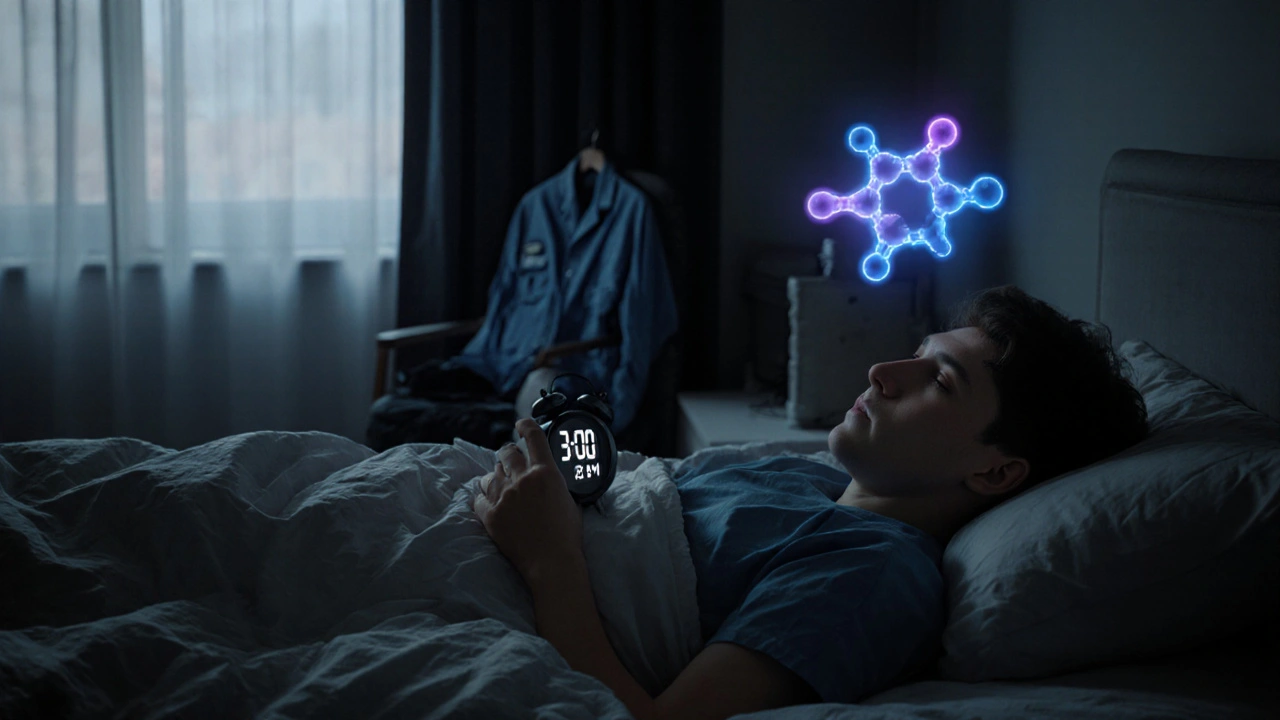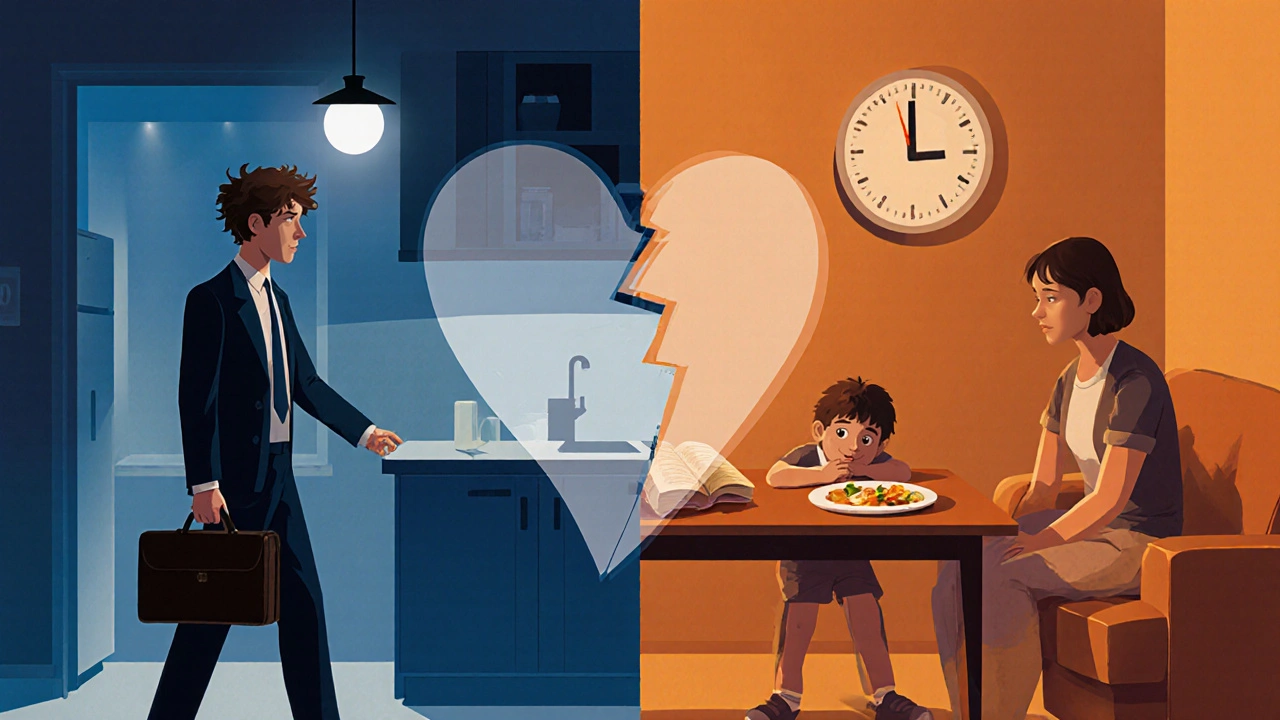
Shift-Work Disorder Impact Checker
This interactive tool helps visualize how shift-work disorder symptoms impact relationships, family dynamics, and social connections. Select a symptom below to see its specific effects.
Excessive Fatigue
Low patience, missed social events
Relationship ImpactInsomnia
Reduced intimacy, irritability
Relationship ImpactNight-time Alertness
Shifted daily routines, misaligned schedules
Relationship ImpactHormonal Imbalance
Decreased libido, mood swings
Relationship ImpactSocial Isolation
Feeling misunderstood, withdrawal from friends
Social ImpactFamily Disruption
Disrupted bedtime rituals, reduced quality time
Family ImpactSymptom Impact Details
Select a symptom card above to see detailed information about how it impacts relationships, family, or social life.
Coping Strategies
- Synchronize sleep windows: Even a 30-minute overlap helps preserve togetherness.
- Use blackout curtains: Protect melatonin production during daytime sleep.
- Plan high-energy activities: Match activities with alert periods.
- Communicate expectations: Discuss event attendance and availability.
- Seek workplace support: Flexible scheduling and nap rooms can help.
When you hear Shift-Work Disorder is a chronic sleep condition caused by irregular work hours that clash with the body’s natural circadian rhythm, you might think it’s just about feeling tired.
In reality, the ripple effect reaches far beyond the bedroom. Partners, kids, friends, and even your own sense of belonging can take a hit. Below we break down why the disorder matters for love life, family, and social circles, and give you practical steps to keep the strain from turning into a breakup.
What Exactly Is Shift-Work Disorder?
Shift-Work Disorder (SWD) is classified by the American Academy of Sleep Medicine as a circadian‑rhythm sleep‑wake disorder. It happens when a person’s work schedule forces sleep at odds with the internal Circadian Rhythm, the roughly 24‑hour cycle that regulates hormone release, body temperature, and alertness. When the rhythm is out of sync, melatonin production-your body’s natural sleep‑inducing hormone-gets delayed or suppressed, leading to chronic sleep deprivation.
How the Body Reacts: From Melatonin to Fatigue
The hormone Melatonin is released by the pineal gland when darkness falls, signalling the brain that it’s time to wind down. Night‑shift workers often work under bright lights when melatonin should be peaking, so the signal never arrives. The result? Persistent Fatigue a state of physical and mental exhaustion that reduces performance and mood, irritability, and a weakened immune system.
Everyone’s natural sleep‑wake preference, or Chronotype describes whether a person is a "morning lark" or "night owl" based on genetics and lifestyle, influences how badly they feel the mismatch. A night‑owl forced onto a dawn‑shift schedule will typically experience sharper drops in alertness than a morning‑type on the same shift.
Romantic Relationships: Why the Bedtime Battle Matters
Intimacy relies on timing, emotional safety, and shared energy. When one partner is chronically sleep‑deprived, several things happen:
- Decreased libido - low testosterone and high cortisol blunt desire.
- Heightened Relationship Stress the tension that builds when communication breaks down and expectations aren’t met - irritability makes small disagreements feel like big fights.
- Unpredictable availability - the night‑shift worker may be home when the partner wants to go out, and vice‑versa.
Research from the University of Oxford (2023) showed couples where one partner worked rotating shifts reported a 27% higher divorce rate than couples with regular schedules. The key driver wasn’t the shift itself, but the lack of consistent emotional connection.
Family Dynamics: Parenting While On‑Call
Kids need predictable routines. When a parent’s sleep schedule flips every few weeks, children can experience:
- Disrupted bedtime rituals - leading to their own sleep problems.
- Reduced quality time - fatigue means less play, homework help, or bedtime stories.
- Emotional confusion - mixed signals about who’s “present” when.
These effects compound over time. A longitudinal study in the Journal of Occupational Health (2022) linked chronic SWD in parents to a 15% increase in behavioural issues among school‑aged children.
Below is a quick visual of how common symptoms translate into relationship challenges.
| Symptom | Typical Relationship Effect |
|---|---|
| Excessive fatigue | Low patience, missed social events |
| Insomnia | Reduced intimacy, irritability |
| Night‑time alertness, day‑time sleepiness | Shifted daily routines, misaligned schedules |
| Hormonal imbalance | Decreased libido, mood swings |
| Social isolation | Feeling misunderstood, withdrawal from friends |

Friendships and Social Life: The Hidden Cost
Social outings often happen in the evenings-precisely when night‑shift workers are on the clock. The result is a gradual drift from friend groups. Over time, the perception of "being unavailable" can turn into a self‑fulfilling prophecy: you skip gatherings, and friends stop inviting you.
Moreover, fatigue can make small‑talk feel exhausting, leading to fewer spontaneous conversations at work. This can erode the informal support networks that buffer stress.
Practical Coping Strategies for Couples and Families
There’s no magic pill (though a doctor might prescribe melatonin under supervision). Most success comes from coordinated habits:
- Synchronise sleep windows - even a 30‑minute overlap before or after a shift helps preserve a sense of togetherness.
- Use blackout curtains and white‑noise machines for daytime sleep to protect melatonin production.
- Plan ‘high‑energy’ activities during the worker’s alert periods and reserve low‑key moments for off‑shift days.
- Talk openly about expectations - discuss how many nights per week each partner can reasonably attend family events.
- Seek occupational health support - many employers offer flexible scheduling, nap rooms, or light‑therapy boxes.
When children are involved, create a visual calendar that marks "parent on‑call" days, so kids know when to expect bedtime stories or help with homework. Consistency, even if limited, builds trust.
Workplace Interventions That Help Relationships
Employers can make a difference:
- Implement rotating‑shift limits (no more than 3 consecutive night shifts).
- Provide on‑site rest areas with dim lighting.
- Offer education sessions on sleep hygiene and relationship health.
- Allow flexible start times after a series of night shifts to aid recovery.
When companies invest in these measures, turnover drops and employee satisfaction climbs. A 2024 UK NHS report found that units with dedicated sleep‑wellness programs reported a 12% reduction in staff‑family conflicts.
Quick Checklist: Protect Your Relationships While Working Shifts
- Schedule at least one shared “wind‑down” routine each week.
- Keep bedroom dark and cool for daytime sleep.
- Limit caffeine after the first half of your shift.
- Communicate upcoming schedule changes at least two weeks in advance.
- Ask your employer about light‑therapy options.
Frequently Asked Questions
Can melatonin supplements fix Shift-Work Disorder?
Melatonin can help reset the sleep clock, but it works best when paired with consistent sleep timing and limited light exposure. Always talk to a healthcare professional before starting any supplement.
Is it normal to feel isolated from friends?
Yes. The mismatch between typical social hours and your work schedule often leads to missed events. Planning regular virtual catch‑ups or weekend meet‑ups can bridge the gap.
What can my partner do to help?
Support starts with understanding. Encourage a shared sleep‑friendly environment, respect your need for quiet time after a night shift, and help with household chores when you’re exhausted.
Are there legal protections for shift workers in the UK?
The Working Time Regulations require adequate rest breaks and a maximum 48‑hour workweek (unless you opt out). Some sectors also have specific guidelines for night‑time work. Check with your HR department for the latest policies.
How long does it take to adapt to a new shift schedule?
Adaptation varies, but most people need at least 2-3 weeks for their circadian rhythm to adjust. Consistency is crucial; irregular changes reset the clock each time.
10 Comments
Nicole Povelikin
October 11 2025
i cant beleive people think this is just about bad sleep its clearly a social experiment . they ignore the real cause and thats the problem .
Michelle Weaver
October 18 2025
Shift‑Work Disorder is a serious condition that warrants a comprehensive approach it is not enough to rely on caffeine or occasional naps the evidence suggests that structured sleep hygiene can markedly improve outcomes 😊 moreover, involving partners in the planning process fosters mutual understanding and reduces friction 😊 finally, employers should consider light‑therapy interventions as a cost‑effective measure to support their staff 😊
John Keough
October 25 2025
The ripple effects of shift‑work stretch far beyond the bedroom, infiltrating every facet of daily life.
The moment a partner’s circadian rhythm is out of sync, the household rhythm collapses, leaving both parties adrift.
This misalignment erodes spontaneous moments of connection, turning them into scheduled, often forced, interactions.
Over time, the accumulated stress manifests as irritability, decreased libido, and a lingering sense of detachment.
Children, too, pick up on the inconsistency, developing anxiety around bedtime because the routine they rely on keeps shifting.
Studies have shown that chronic exposure to such irregular schedules can impair a child’s emotional regulation and academic performance.
For the worker, chronic fatigue reduces cognitive flexibility, making it harder to negotiate household responsibilities or remember important dates.
Partners often report feeling invisible, as the night‑shift worker retreats into a darkened room to catch fragmented sleep.
The solution begins with open communication, where both sides articulate realistic expectations without blame.
Establishing a shared “wind‑down” ritual, even if brief, signals a commitment to the relationship despite the schedule.
Synchronizing at least a half‑hour of overlapping awake time each day can preserve intimacy and facilitate daily check‑ins.
Practical tools such as blackout curtains, white‑noise machines, and consistent sleep‑window scheduling can stabilize the worker’s internal clock.
Employers can further alleviate strain by limiting consecutive night shifts and providing on‑site nap pods or light‑therapy boxes.
When workplaces adopt these measures, staff report higher job satisfaction and fewer reports of family conflict.
Ultimately, the burden of shift‑work does not have to erode relationships; with intentional habits and supportive environments, couples can maintain a strong bond even under the most demanding schedules.
Graham Smith
November 2 2025
The article contains several misplaced commas and inconsistent capitalization; for example, “night‑time Alertness” should not capitalize the second word. Also, “relationship stress” is missing a period after the preceding sentence.
Jeremiah Morgan
November 9 2025
It is heartening to see such a thorough exploration of shift‑work impacts, and I commend the authors for highlighting practical coping mechanisms. By fostering empathy within families and encouraging employers to adopt flexible policies, we can mitigate many of the challenges described. Remember, consistency in small gestures often yields the greatest emotional dividends, even when the larger schedule feels chaotic.
nina greer
November 16 2025
One might argue that the discourse merely grazes the profound ontological ramifications of chronobiological desynchronization.
Montague Tilmen
November 23 2025
This whole whining about shift work is nothing but a soft‑sell for foreign corporate interests that undermine American work ethic. Real patriots stand up to the night‑shift agenda and demand schedules that respect our nation's productivity. Anything less is a betrayal of our sovereignty.
Clarise Wheller
November 30 2025
I love how the post emphasizes teamwork between partners and employers; it really shows that we can all pull together for better sleep health. Let’s keep sharing tips and supporting each other’s routines. Together we’ll build stronger families despite the odd hours.
Riley Fox
December 7 2025
Ah, the paradox of time, where the clock ticks both forward and backward, yet we remain shackled to its tyranny; isn’t that a splendid illustration of modern existential dread, dear readers?; indeed, the proposed interventions may soothe the weary, but they also mask the deeper societal malaise;; 😕 however, one must question whether true harmony can ever be achieved under artificial illumination;; the answer, perhaps, lies within the silence of the night itself, if only we dare to listen;; 😐






Evan Riley
October 4 2025
Look, the whole shift‑work narrative is a smokescreen pushed by corporate overlords to keep us glued to the grinding wheel. They paint it as a personal health issue, but the truth is they’re engineering chronic fatigue to blunt worker resistance. If you keep sleeping on a rotating timetable, you’ll never mount a coherent protest against the 24/7 economy. It’s not just about tiredness; it’s about control.